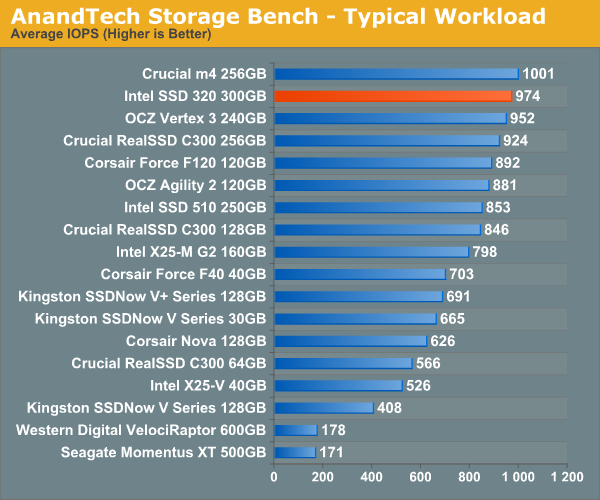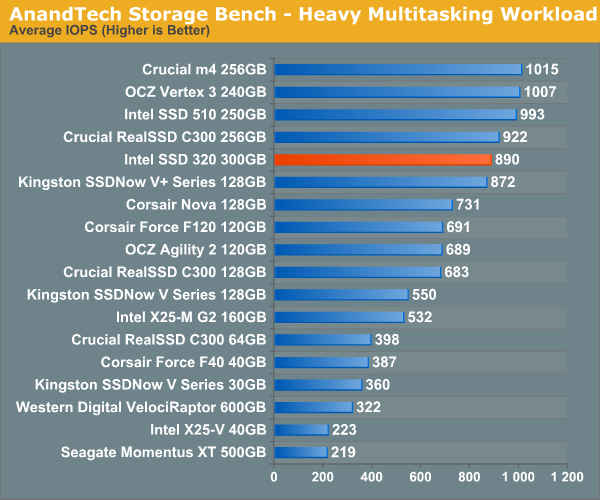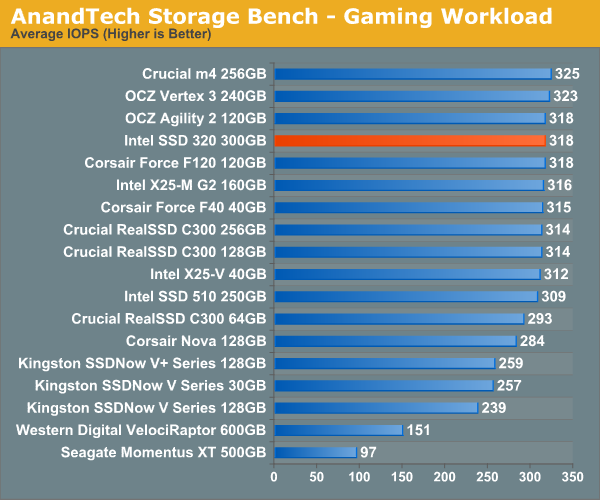The Intel SSD 320 Review: 25nm G3 is Finally Here
by Anand Lal Shimpi on March 28, 2011 11:08 AM EST- Posted in
- IT Computing
- Storage
- SSDs
- Intel
- Intel SSD 320
AnandTech Storage Bench 2010
To keep things consistent we've also included our older Storage Bench. Note that the old storage test system doesn't have a SATA 6Gbps controller, so we only have one result for the 6Gbps drives.
The first in our benchmark suite is a light/typical usage case. The Windows 7 system is loaded with Firefox, Office 2007 and Adobe Reader among other applications. With Firefox we browse web pages like Facebook, AnandTech, Digg and other sites. Outlook is also running and we use it to check emails, create and send a message with a PDF attachment. Adobe Reader is used to view some PDFs. Excel 2007 is used to create a spreadsheet, graphs and save the document. The same goes for Word 2007. We open and step through a presentation in PowerPoint 2007 received as an email attachment before saving it to the desktop. Finally we watch a bit of a Firefly episode in Windows Media Player 11.
There’s some level of multitasking going on here but it’s not unreasonable by any means. Generally the application tasks proceed linearly, with the exception of things like web browsing which may happen in between one of the other tasks.
The recording is played back on all of our drives here today. Remember that we’re isolating disk performance, all we’re doing is playing back every single disk access that happened in that ~5 minute period of usage. The light workload is composed of 37,501 reads and 20,268 writes. Over 30% of the IOs are 4KB, 11% are 16KB, 22% are 32KB and approximately 13% are 64KB in size. Less than 30% of the operations are absolutely sequential in nature. Average queue depth is 6.09 IOs.
The performance results are reported in average I/O Operations per Second (IOPS):

If we strip 6Gbps out of the equation completely, the SSD 320 does very well in our old light workload. You're looking at performance that's at the top of the pack from the mainstream offering.
If there’s a light usage case there’s bound to be a heavy one. In this test we have Microsoft Security Essentials running in the background with real time virus scanning enabled. We also perform a quick scan in the middle of the test. Firefox, Outlook, Excel, Word and Powerpoint are all used the same as they were in the light test. We add Photoshop CS4 to the mix, opening a bunch of 12MP images, editing them, then saving them as highly compressed JPGs for web publishing. Windows 7’s picture viewer is used to view a bunch of pictures on the hard drive. We use 7-zip to create and extract .7z archives. Downloading is also prominently featured in our heavy test; we download large files from the Internet during portions of the benchmark, as well as use uTorrent to grab a couple of torrents. Some of the applications in use are installed during the benchmark, Windows updates are also installed. Towards the end of the test we launch World of Warcraft, play for a few minutes, then delete the folder. This test also takes into account all of the disk accesses that happen while the OS is booting.
The benchmark is 22 minutes long and it consists of 128,895 read operations and 72,411 write operations. Roughly 44% of all IOs were sequential. Approximately 30% of all accesses were 4KB in size, 12% were 16KB in size, 14% were 32KB and 20% were 64KB. Average queue depth was 3.59.

Crank up the workload and the 320 falls a bit behind the rest of the competitors. Last year's heavy multitasking workload is nothing compared to what we introduced earlier this year, so it's still pretty light by comparison but it's clear for normal usage the 320's 3Gbps performance is quite good.
The gaming workload is made up of 75,206 read operations and only 4,592 write operations. Only 20% of the accesses are 4KB in size, nearly 40% are 64KB and 20% are 32KB. A whopping 69% of the IOs are sequential, meaning this is predominantly a sequential read benchmark. The average queue depth is 7.76 IOs.











194 Comments
View All Comments
bji - Tuesday, March 29, 2011 - link
I think that garbage collection refers to a process of deferring block erases to a later time to be done when the drive is otherwise idle. I.e., if you need to rewrite a block you don't re-write it in place, you write it to a block from the spare area that is already cleared thus saving yourself the time of having to erase the old block before rewriting it. You still mark the old block as needing to be cleared and put into the spare area (to replace the block that was taken out of the spare area during this process), and you do that later during 'garbage collection'.There may also be some aspects to which individual blocks from an erase region (my understanding of the terminology is a bit off but I am pretty sure that flash memory can write to smaller regions than it can erase) are moved around during 'garbage collection' to consolidate them into single blocks; this takes blocks that are interspersed with dead area and collapses them down to a smaller fully populated region, then takes all of the now-free blocks and then erases them and puts them in the spare area.
Having TRIM makes both of these processes more efficient because it tells the drive that it can just mark blocks as ready-for-erase-and-put-into-the-spare-area immediately rather than having to be tracked and managed, and also increases the overall spare area available which means that more already-erased blocks are ready to be used for writes. Having to erase a block before writing it is the performance killer of SSDs and TRIM, along with intelligent algorithms listed above, in addition to things I haven't even thought of most likely, are what allow SSDs to get around the erase block performance penalty and to have such killer performance.
randomlinh - Monday, March 28, 2011 - link
I was excited to see this back when it was "announced." I was hoping we'd be closer to $1/GB for the mainstream performance around now, but looks like I've still got to wait.Hoping the 2011 round of controllers push intel to compete with pricing. I'm happy with the performance honestly, but need pricing.
Or maybe this will drive the x25-Ms down in price and I'll just RAID-0 a pair of 80GB's...
Ushio01 - Monday, March 28, 2011 - link
So all we get from Marvel and Intel are there old controllers working as they should of from the beginning with only Sandforce actually innovating, pathetic.darckhart - Monday, March 28, 2011 - link
"should have been" maybe. but we all know that's not how business works. sell it, revise it, sell it, revise it, ad nauseum. in any case, know this: they are getting comparable SF-12xx performance WITHOUT realtime compression and dedup which is mighty impressive in my book.darckhart - Monday, March 28, 2011 - link
oh i forgot to mention they're doing this on 25nm.Vlad T. - Monday, March 28, 2011 - link
Planned obsolescence or built-in obsolescence.http://en.wikipedia.org/wiki/Planned_obsolescence
That is even more obvious considering how Intel trashes G2 with the same controller.
thudo - Monday, March 28, 2011 - link
My gawd how the mighty have fallen? Doesn't remotely hold its own against the mighty Vertex 3 (SATA3). 120Gb Vertex 3 as now showing up in Canada for ~$290 -- a frick'n steal considering my boot drives have always been ~100-150Gb+ (all you need) and the performance increase is so well worth it. Shame Intel.. shame..davepermen - Monday, March 28, 2011 - link
you know that intel has the 520 ssds, too? those are to fight vertex3.not that i would ever consider ocz an ssd worth buying anyways, but lets not discuss that. anand loves them after he hated them. i still can't (as even after anand has forgiven them, they continue the same crap they did before).
so for a sata3 system, it's 520. for a sata2 system, the 320 is fine, actually nearly perfect.
sean.crees - Tuesday, March 29, 2011 - link
Say what you will of OCZ, at least they listen to their consumers, and attempt to make legitimate changes in their business practices to satisfy their existing customer base.Intel has it's advantages, but appeasing it's current customers are not one of them. Ask the numerous amounts of people that jumped on Intel's 1st gen SSD bandwagon to then be shunned from TRIM support forever, which would require nothing but a firmware upgrade. 2x 80gb for $500 each, and no TRIM support. These things have slowed to almost HDD performance.
shatteredx - Monday, March 28, 2011 - link
Performance is fine, but Intel isn't pricing these drives cheaply enough.Whatever happened to the prediction that 25nm drives would cost half as much as their 34nm siblings?